Browse the top 250 universities in this year’s rankings
Hong Kong University of Science and Technology has been crowned the world’s best young university in a new Times Higher Education ranking.
The Asian institution has for the first time topped the 2018 THE Young University Rankings, which includes only universities that are 50 years old or younger, after ranking in second place last year.
The 27-year old HKUST has knocked former champion École Polytechnique Fédérale de Lausanne in Switzerland, which is 49 years old, into second place.
Meanwhile, two newcomers make the top 10 this year. Paris Sciences & Lettres – PSL University joins at fourth place, while the University of Alabama at Birmingham makes its debut in 10th place. Both institutions featured in the THE World University Rankings for the first time last year.
- Middleweight titles: the top 200 Golden Age universities
- Millennial institutions: the best of those founded since 2000
- Browse our global portfolio of university rankings
The 2018 young table includes 250 universities, up from 200 in 2017.
The UK is the most-represented country, with 31 universities, but it does not have any institutions in the top 40. Its top-ranked university is Brighton and Sussex Medical School at joint 47th.
The Young University Rankings are part of a suite of THE tables focused on universities that, unlike many of the world’s top-ranked universities, do not have centuries of history or tradition.
The Golden Age ranking, which has been compiled for the second time this year, lists the top 200 “middle-aged” universities that were founded between 1945 and 1967.
Meanwhile, the universities in the “under 50” list have been split into three tables in order to take a closer look at the different generations of young universities: Generation X universities (founded between 1968 and 1985), Generation Y universities (founded between 1986 and 1999) and Millennial universities (founded since the year 2000).
The Young University Rankings and its composite tables is based on the same 13 performance indicators as the THE World University Rankings, but the weightings have been adjusted to give less weight to reputation.
The Golden Age ranking uses the same methodology as the World University Rankings.
ellie.bothwell@timeshighereducation.com
THE Young University Rankings 2018: top 10
| Young University Rank 2018 | Young University Rank 2017 | World University Rank 2018 | Institution | Country/region |
| 1 | 2 | 44 | Hong Kong University of Science and Technology | Hong Kong |
| 2 | 1 | 38 | École Polytechnique Fédérale de Lausanne | Switzerland |
| 3 | 3 | 52 | Nanyang Technological University | Singapore |
| 4 | NR | 72 | Paris Sciences & Lettres – PSL University | France |
| 5 | 6 | 103 | Maastricht University | Netherlands |
| 6 | 5 | 95 | Korea Advanced Institute of Science and Technology (KAIST) | South Korea |
| 7 | 7 | 119 | City University of Hong Kong | Hong Kong |
| 8 | 4 | 137 | Pohang University of Science and Technology | South Korea |
| 9 | 9 | 155 | Scuola Superiore Sant’Anna | Italy |
| 10 | NR | 168 | University of Alabama at Birmingham | United States |
Click here to browse the full results of the 2018 Young University Rankings

Gaining momentum
The multidisciplinary approaches of ‘accelerated universities’ are enabling them to excel. We examine the vision driving top performers
Paris Sciences & Lettres – PSL University has a simple, if elusive, mission, says its president, Alain Fuchs: to create “a new research-based, world-class, internationally visible university by integrating institutions that are quite good, but simply too small to compete at an international level”.
The merger of nine institutions was established in 2010, but it is already producing results. It is the highest new entry in the Times Higher Education Young University Rankings 2018, which lists the world’s best universities that are 50 years old or younger, joining at fourth place. This is the first rankings cycle that the single collegiate institution, rather than its individual components, has been ranked.
Compared with its youthful peers, PSL does particularly well when it comes to its teaching environment. It is third when ranked on this pillar alone.
Fuchs says that one big advantage of merging universities rather than building a new institution from scratch is that you can “mutualise administrative tasks, rather than centralising them”, by giving each college responsibility for managing one service for all the institutions in the group.
“We are very much afraid of building up a thick layer of bureaucracy, like the kind of thing you can see in some old universities,” he says.
He adds that it might have been tempting to “build up scientific departments across the different colleges”, for example by creating a super-sized physics department across the institution, but the university resisted this strategy because “in many of the old global universities that we know of in the world, disciplinary departments are not extremely agile”.
Instead, the university created “very interdisciplinary mixed education and research programmes”.
“This provides us with much more agility and the possibility of inventing new education programmes without having to negotiate between, for example, a biology department on the one hand and a physics department on the other,” he says.
PSL is not the only striking change at the top of the Young University Rankings, which annually excludes universities when they reach their 51st birthday.
The most eye-catching development is that Hong Kong University of Science and Technology has swapped places with École Polytechnique Fédérale de Lausanne to claim the number one spot.
HKUST, which was founded in 1991, improved on four main areas: teaching environment, research environment, citation impact and international outlook.
Its acting president Wei Shyy says that while the university has “limited manpower and resources”, it “has a clear positioning of the research spectrums we want to excel in…that would keep us abreast with the needs of the modern-day society”. These include artificial intelligence, data science, public policy and sustainability, to name a few.
This “clear vision” has enabled the institution to produce a high volume of research with “major impact in their own areas – such as our researchers’ discoveries in the mechanisms under Alzheimer’s disease, which could bring [about a] cure, or our computer scientists cracking the code of HIV using big data”, he adds.
On the teaching front, HKUST has been “steering our curriculum towards a multidisciplinary, highly individualised and student-driven direction over the past decade”, says Shyy. For example, it has created an Individualized Interdisciplinary Major, in which undergraduates can create their own programme of study that addresses their individual interests.
The whole world says interdisciplinarity is essential but very few universities can step away from their traditional structure to get there,” says Liz Reisberg. She is an international higher education consultant and co-editor of the recently published book Accelerated Universities: Ideas and Money Combine to Build Academic Excellence , which includes case studies of nine universities that have “catapulted from concept to international prominence in a remarkably short time”. HKUST and EPFL form two of these case studies.

But Reisberg adds that, because the universities in the case studies were created outside the higher education establishment in their countries, “they have a lot more latitude to be innovative in the way they organise their programmes and most of them opted for interdisciplinary curricula”.
While the location and mission of the Young University Rankings is diverse – especially so this year, because of the expansion to include 250 universities, up from 200 in 2017 – a notable trend is the high number of institutions focused on engineering and technology. Such universities claim six of the top 10 places.
Ulsan National Institute of Science and Technology, another highly ranked newcomer, also fits this profile. Established in 2009, it is the youngest brand new university in the ranking. Although other institutions in the table have earlier foundation dates, they formed as a result of mergers.
It claims 24th place overall, but is fifth when universities are ranked solely on citation impact.
Pompeu Fabra University in Spain, founded in 1990, is also a strong performer in terms of the influence of its research. It is ranked 11th overall, up from 17th last year, and is second in the citation impact metric.
As well as improving on this measure, its scores for teaching and research environment are also higher compared with last year.
Rector Jaume Casals says the most important factor “to create a research university that also seeks to assume a leading social role in education is to recruit talented people, both teachers and students – the more unique and valuable, the better”.
He adds that the university is currently developing a project to help it become globally recognised for teaching and cross-disciplinary research around “planetary wellbeing” – “the idea that to safeguard human health we need to maintain the health of the planet on which we depend”.
Casals says that while UPF’s international reputation and its visibility are “still limited” because of its age and size, it is “a flexible institution that works with efficiency, clarity, rigour and immediacy and is able to adapt to the context and needs of its community”.
However, he cites Spain’s rigid higher education regulations as a barrier to attracting academic talent and “one of the major challenges we are trying to face”.
It is tempting to think of the creation of “accelerated universities” as a relatively new phenomenon – many of the immediate examples that come to mind, such as HKUST, are based in Asia and date back to the past couple of decades.
But Philip Altbach, research professor and founding director of the Center for International Higher Education at Boston College and co-editor of the book Accelerated Universities , says that while they are rare, they are not new. The University of Chicago, for example, was established in 1892 “to build a German-style research university” in what was then the fastest-growing city in the world, he says.
Reisberg says there are several reasons why countries would want to create “accelerated universities”.
Click here to read the methodology of the 2018 Young University Rankings
“In some cases it’s because there isn’t a research-intensive university of world-class stature, sometimes it’s about the need to build a knowledge-based dimension of the economy, sometimes it’s the pursuit of rankings and for international prestige. In the case of Singapore [University of Technology and Design] there are some very strong universities but it added something that didn’t already exist,” she says.
“And then there is a parallel move. The alternative to building new universities – if you can’t come up with the funding necessary – is the excellence initiatives that you see in Germany, Russia, China to…put a lot of extra money into [a few] universities to notch them up to a much higher level.”
Altbach adds that in many cases, the idea is to create a “new model” of university that other institutions in the country “can look at and emulate or at least take some ideas from”.
“If they have a lot of money they’ll be hiring a lot of smart people who can interact with the rest of the system,” he says.
So how should countries or individuals go about creating such an institution?
“For me the key ingredients are money, talent and vision,” says Reisberg. “You’ve got to have a vision that can take you into something that doesn’t exist and then build it.”
But Altbach warns that we shouldn’t expect to see an influx of new “accelerated universities”.
“There’s not going to be a huge number of them because they take tons of money and innovative and interesting ideas – and neither of those things are falling off trees.”






